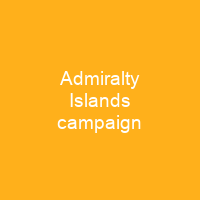The Admiralty Islands Campaign: A Turning Point in World War II
Imagine a pivotal moment in history where the fate of an entire campaign hung by a thread—this is what the Admiralty Islands campaign was like during World War II. The battle for these islands, codenamed Operation Brewer, marked a significant turning point in the Pacific theater. Was it a bold move or a reckless gamble?
The Strategic Importance of the Admiralties
The Admiralty Islands were strategically crucial. They served as a potential alternative base to Rabaul, which was under heavy Allied attack. The islands offered a chance for the Allies to weaken Japanese defenses and establish a new stronghold. Could these small islands hold such immense strategic value?
A Race Against Time
The campaign began on February 29, 1944, when American forces landed on Los Negros. The timing was critical; the Allies needed to act quickly before Japanese reinforcements could arrive. Would they be able to secure these islands in time?
The Battle for Hyane Harbour
The landing site chosen by the Allies was a small beach near the Momote airstrip, but it came with its own set of challenges. The weather was poor, and Japanese forces were waiting just beyond the safety of their dugouts. How would the Americans overcome these obstacles?
A Cautious Advance
The initial landing went smoothly, but once the bombardment lifted, the reality hit hard. Machine guns emerged from both sides of Hyane Harbour, forcing the Allies to retreat and regroup. Could they hold their position against such fierce resistance?
Logistical Challenges
The follow-up force arrived six hours later, with LSTs beaching in Hyane Harbour under mortar fire. The process of unloading supplies was fraught with danger, but it was essential for the campaign’s success. How did they manage to keep their momentum going despite these challenges?
The Battle of Papitalai Mission
The road to Salami was difficult due to mud and Japanese obstacles. The tanks fired canister shot shells into buildings and high-explosive shells into bunkers, but the advance was delayed by a minefield. Would they be able to overcome these obstacles?
Airbase Development
The development of airbases in the Admiralty Islands was crucial for the Allies’ success. The construction of Momote airfield required stripping away humus and laying a new coral surface, while Manus base development was taken over by the 5th Naval Construction Regiment. How did these bases impact the campaign?
The Legacy of Operation Brewer
The loss of the Admiralties meant the loss of Imperial Headquarters’ outpost line in the South Eastern Area and led to the preparation of a new line in Western New Guinea. The campaign indicated the Allies were becoming more ambitious, with preparations underway to defend Aitape and Wewak as well. Would this change the course of the war?

The Admiralty Islands campaign was a complex and challenging operation that tested the limits of Allied strategy. It marked a significant shift in the Pacific theater, with the Allies achieving a 1:4 superiority in the opening stages of the battle. The value of these islands to the Allies was enormous, saving lives and speeding up the Allied advance by several months. Would you have taken this risk?
The Admiralty Islands campaign stands as a testament to the determination and strategic acumen of the Allied forces during World War II. It was a bold move that paid off, turning the tide in favor of the Allies and paving the way for further advancements in the Pacific theater.
You want to know more about Admiralty Islands campaign?
This page is based on the article Admiralty Islands campaign published in Wikipedia (retrieved on November 28, 2024) and was automatically summarized using artificial intelligence.







